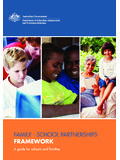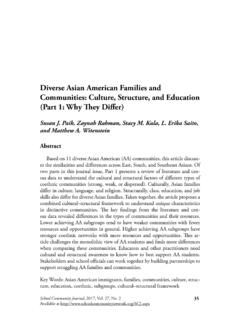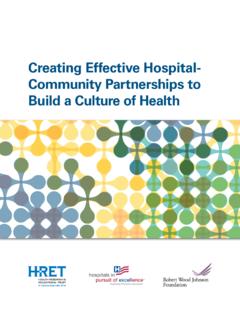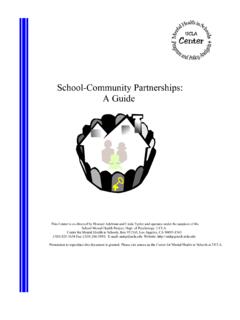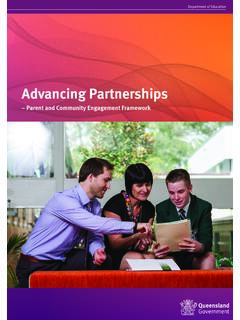Transcription of Beyond Involvement and Engagement: The Role of the Family ...
1 135 School Community Journal, 2016, Vol. 26, No. 2 Available at Beyond Involvement and Engagement: The Role of the Family in School Community PartnershipsAmanda Stefanski, Linda Valli, and Reuben JacobsonAbstract Research indicates that partnerships between schools and neighborhood communities support student learning, improve schools, and strengthen fami-lies and neighborhoods. These partnerships expand the traditional educational mission of the school to include health and social services for children and their families and to involve the broader community. School community partner-ships typically arise out of a specific need in the community and, as such, differ across a range of processes, structures, purposes, and types of Family involve-ment. In previous work, we developed a typology to more closely examine various school community partnerships (Valli, Stefanski, & Jacobson, 2013).
2 From that review of the literature, we identified four increasingly complex and comprehensive partnership models. In this article, we reexamine the literature, focusing on the role of the Family in those partnership models, and discuss implications for productive Family school community relations. Our analysis of the literature indicates that the role of parents and families differed con-siderably across the four models. In contrast to the simple Family Involvement versus Family engagement dichotomy found in much of the current literature, we found eight distinct ways in which Family roles were envisioned and enact-ed. This article provides a detailed picture of those roles to guide policies and practices that strengthen the Family s role in school community partnerships.
3 SCHOOL COMMUNITY JOURNAL136 Key Words: Involvement , engagement, Family role, school community part-nerships, models, parents, full service community schools, wraparound ser-vices, development, interagency collaboration, families , linkedIntroductionSchool community partnerships have long been viewed as a promising way to help struggling students, families , and neighborhoods. In the Progressive Era, the local school was commonly viewed as the community s central insti-tution (Dewey, 1902). Schools served as places where community members could hear lectures, debate about civic issues, and use the facility for recreation at night, on weekends, and during school breaks. Social reformers from out-side the school system including muckrakers, activists, public health doctors, women s clubs, and settlement-house workers sought to improve the lives of children and families in the school setting.
4 These reformers advocated for a larger role of government in helping poor families and for more services at the school site, both during and outside the regular school day (Tyack, 1992). A few of the many new services were vocational guidance, lunches, playgrounds, sex education, health programs, and vacation schools (Cohen, 2005; Sedlak & Schlossman, 1985; Tyack, 1992). A variety of community associations worked with and within these community schools. Sometimes these working relation-ships took the form of mutual partnerships; at other times, the relationship resembled a patronage system, with a foundation or influential organization bestowing aid on a needy in large part by the seminal work of Joy Dryfoos, the early 1990s witnessed a resurgence of the community school movement.
5 Working in the public health sector, Dryfoos (1994) argued that schools cannot meet the needs of students on their own, but must coordinate with social service systems and become full-service schools. A year later, the president of the American Ed-ucational Research Association advanced this agenda, advocating for a new paradigm of schooling, a paradigm that linked health, social welfare, juvenile justice, extended day educational opportunities, [and] community partici-pation (Stallings, 1995, p. 8). More recently, neighborhood transformation efforts such as the Harlem Children s Zone as well as grant competitions such as the Choice Neighborhoods, Full-Service Community Schools, and Promise Neighborhood programs have renewed interest in this paradigm.
6 The Promise Neighborhood grant competition, for example, required school community partners to develop an integrated system of educational programs and Family /community supports with great schools at the center ( Department of Education, 2012). SCHOOL COMMUNITY PARTNERSHIPS137As Harris and Hoover (2003) have written, Dryfoos s work became a ral-lying point for those striving to advance partnership agendas (p. 206). Today, community schools and similar collaborative initiatives rely on numerous types of partners to support their efforts. In some cases, organizations such as the Children s Aid Society ( communities in Schools [CIS], 2010) take the lead in establishing the focus of the partnership . In other cases, school districts ini-tiate partnerships with one or more organizations.
7 In the city of Boston, for instance, the public school system has had a long-standing partnership with the Full-Service Schools Roundtable, a coalition of over 150 members (Weiss & Siddall, 2012). A driving assumption behind each of these partnerships is that the expansion of the academic mission of the school to include health and social services for children and families and to involve the broader community will benefit both individuals and society. Indeed, such partnerships have been found to support student learning, improve schools, and assist families (Hen-derson & Mapp, 2002; Valli, Stefanski, & Jacobson, 2014; Walsh et al., 2014).But in the struggle to define the movement, exactly how are partnership roles conceptualized and enacted?
8 The general theory of action underlying partnerships provides the beginning of the answer: Positing that schools serve students academic needs better if they can quickly and efficiently attend to the overall health and well-being of children and their families (Epstein, 1995; Krenichyn, Clark, & Benitez, 2008), partnership advocates push for a closer working relationship with parents and Family members. In this article, we re-view the literature on the ways in which school community partnerships have included families . Our goal is to provide a more detailed understanding of closer working relationships that, as the theory of action suggests, should result in an array of social and academic benefits. We begin with the develop-mental and sociological perspectives that underlie this theory of action.
9 We then review the previous literature on parent Involvement , explain the typology of partnerships we developed, and analyze findings on Family roles within the four partnership models. Perspectives and Frameworks: Family RolesDevelopmental theorists emphasize the multiple and interrelated dimen-sions of human development: physical, psychological, social, cognitive, ethical, and linguistic. They also argue for an ecological perspective on human devel-opment, that is, examining the environmental contexts (peer, Family , school, neighborhood, etc.) that support or impede healthy development and learn-ing, as well as the interactions among them (Bronfenbrenner, 1979; Comer, Haynes, Joyner, & Ben-Avie, 1996). In their ecological orientation, develop-mentalists intersect with sociological perspectives that point to the persistent SCHOOL COMMUNITY JOURNAL138impact of social capital on student achievement.
10 Defining social capital as net-works of supportive relationships and resources that make goal achievement possible (Bourdieu, 1986), sociologists argue that good health, Family and community support, and employment prospects are key factors in students ac-ademic success (Jencks, 1992; Rothstein, 2004; Wilson, 1999). Bringing those two traditions together, Epstein s (1995) theory of overlapping spheres empha-sizes the importance of schools, families , and communities working together to meet the needs of children. More specifically, a central principle of the theory is that certain goals ( , academic achievement) are of mutual interest to people in each of the three spheres and, therefore, are best achieved through coopera-tive action and , these perspectives provide a powerful rationale for schools not operating as entities separate from Family and community contexts, which is the current norm of public schools, especially in high-poverty neighbor-hoods.












